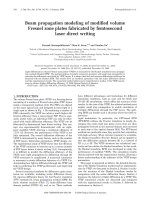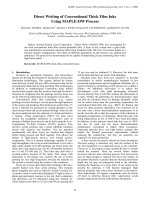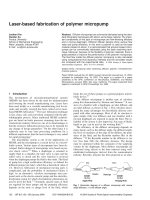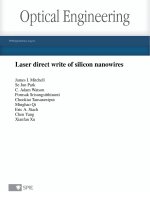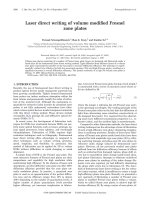laser direct writing of silicon field effect transistor sensors
Bạn đang xem bản rút gọn của tài liệu. Xem và tải ngay bản đầy đủ của tài liệu tại đây (1.17 MB, 5 trang )
Laser direct writing of silicon field effect transistor sensors
Woongsik Nam, James I. Mitchell, Chookiat Tansarawiput, Minghao Qi, and Xianfan Xu
Citation: Appl. Phys. Lett. 102, 093504 (2013); doi: 10.1063/1.4794147
View online:
View Table of Contents:
Published by the American Institute of Physics.
Related Articles
Metamaterial optical refractive index sensor detected by the naked eye
Appl. Phys. Lett. 102, 091902 (2013)
Fast and high resolution thermal detector based on an aluminum nitride piezoelectric microelectromechanical
resonator with an integrated suspended heat absorbing element
Appl. Phys. Lett. 102, 093501 (2013)
A poly(dimethylsiloxane) based prism for surface plasmon resonance imaging system and its application for gas
detection
Rev. Sci. Instrum. 84, 035001 (2013)
Charged particle velocity map image reconstruction with one-dimensional projections of spherical functions
Rev. Sci. Instrum. 84, 033101 (2013)
Elastomeric transparent capacitive sensors based on an interpenetrating composite of silver nanowires and
polyurethane
APL: Org. Electron. Photonics 6, 38 (2013)
Additional information on Appl. Phys. Lett.
Journal Homepage:
Journal Information:
Top downloads:
Information for Authors:
Downloaded 04 Mar 2013 to 128.46.221.170. Redistribution subject to AIP license or copyright; see />Laser direct writing of silicon field effect transistor sensors
Woongsik Nam,
1,2
James I. Mitchell,
1,2
Chookiat Tansarawiput,
2,3
Minghao Qi,
2,3
and Xianfan Xu
1,2,a)
1
School of Mechanical Engineering, Purdue University, West Lafayette, Indiana 47907, USA
2
Birck Nanotechnology Center, Purdue University, West Lafayette, Indiana 47907, USA
3
School of Electrical and Computer Engineering, Purdue University, West Lafayette, Indiana 47907, USA
(Received 30 November 2012; accepted 19 February 2013; published online 4 March 2013)
We demonstrate a single step technique to fabricate silicon wires for field effect transistor sensors.
Boron-doped silicon wires are fabricated using laser direct writing in combination with chemical
vapor deposition, which has the advantages of precise control of position, orientation, and length,
and in situ doping. The silicon wires can be fabricated to have very rough surfaces by controlling
laser operation parameters, and thus, have large surface areas, enabling high sensitivity for sensing.
Highly sensitive pH sensing is demonstrated. We expect our method can be expanded to the
fabrication of various sensing devices beyond chemical sensors.
V
C
2013 American Institute of
Physics.[ />During the past decades, field effect transistor (FET)
sensors, in which the surface potential of the conduction
channel is modulated by charged molecules, have attracted a
great deal of attention for chemical and biological applica-
tions.
1,2
Recently, it has been shown that the use of nano-
scale materials such as silicon nanowires (SiNWs) can
significantly improve the sensitivity of FET sensors,
3,4
allowing detection of a very low concentration of analytes.
Due to the large surface-to-volume ratio,
5
nanoscale Si FETs
are expected to have excellent sensitivity. Label-free, direct
electrical detection is another advantage of FET sensors. By
exploiting these attractive features, SiNW FETs have been
demonstrated for the detection of ions,
3,4,6
proteins,
3,4,7
DNA,
8
virus,
9
and cells.
10
However, complex procedures for
integrating nanowires into a nanosensor remains an obstacle
for widespread applications. The “bottom up” approach
requires assembly of nanowires grown from chemical vapor
deposition (CVD),
11
which not only involves CMOS incom-
patible processes but also suffers from difficulty in precisely
positioning of nanowires. Metal contamination from cata-
lysts used during CVD growth is another disadvantage.
Alternative “top-down” methods are proposed to overcome
these shortcomings, providing CMOS compatibility and pre-
cise control of nanowire position.
4,12–14
The “top-down”
approaches require complex, multiple fabrication steps for
nanowire patterning, etch ing, and doping.
In this work, we report a single-step approach to fabri-
cate boron-doped silicon wires with diameters of a few hun-
dred nm for Si FET sensors. Boron-doped Si wires are
deposited using laser direct writing in combination with
CVD which we previously demonstrated for deposition of
intrinsic SiNWs.
15
The unique feature of the fabricated Si
wires is that they can have very rough surface which is bene-
ficial for sensing applications due to its large surface area. In
addition, our approach features excellent control of position,
orientation, and length, in situ doping, and catalyst-free
growth. The direct deposition of semiconductor wires on an
insulating SiO
2
surface provides a platform ready for subse-
quent device fabrication. Furthermore, the technique have
potential for fabricating sensor arrays with different doping
concentrations, which would enable multiplexed detection of
analytes.
7
Laser direct written Si FETs are employed to
detect the proton concentration (pH) of an aqueous solution.
The excellent sensitivity of our sensor device demonstrates
that our approach offers a simple and promising way to fabri-
cate highly sensitive Si FET sensors.
The fabrication starts with deposition of boron-doped Si
wires using the laser direct write CVD method. A schematic
depicting the technique is shown in Fig. 1(a). A femtosec-
ond, mode-locked Ti:sapphire laser with a wavelength of
800 nm and about 100 fs pulse duration was frequency-
doubled to 400 nm and used to locally heat an area on a sub-
strate. To achieve small dimensions, the laser beam was
focused on a diffraction-limited spot as small as 250 nm
using high numerical aperture Fresnel phase zone plates.
15
The substrate is a 200 nm-thick silicon dioxide top layer over
a 200 nm-thick polycrystalline silicon (poly-Si) layer on
quartz. The silicon dioxide top layer electrically isolated the
deposited Si wires from the substrate, and the poly-Si layer
serves as a means for absorbing laser radiation. The subst rate
was located in a vacuum chamber at a pressure between 30
and 40 Torr with flow of 10% silane in argon and 100 ppm
diborane in hydrogen. In order to obtain a low doping con-
centration of a Si wire desirable for high sensitivity,
16
we
lightly doped our Si wires with a SiH
4
:B
2
H
6
mass flow ratio
of 6000:1. The reactive gases decomposed on the laser spot
due to the thermal energy of the laser and p-type silicon was
deposited. In the meantime, movement of the piezoelectric
stage holding the substrate created silicon lines in a desired
pattern.
Figures 1(b)–1(d) show scanning electron microscope
(SEM) images of Si wires synthesized using laser direct writ-
ing. The length of a Si wire can be precisely controlled up to
200 lm, which is the maximum travel distance of the piezo-
electric stage, with a precision determined by the piezoelec-
tric stage. Si wires with different surface morphologies were
produced by controlling the polarization of the laser beam,
a)
Author to whom correspondence should be addressed. Electronic mail:
0003-6951/2013/102(9)/093504/4/$30.00
V
C
2013 American Institute of Physics102, 093504-1
APPLIED PHYSICS LETTERS 102, 093504 (2013)
Downloaded 04 Mar 2013 to 128.46.221.170. Redistribution subject to AIP license or copyright; see />analogous to the formation of laser induced surface struc-
tures.
17
The wire in Fig. 1(b) was created with horizontally
polarized light, while the wires in Figs. 1(c) and 1(d) were
created with circularly polarized light. For sensor fabrica-
tion, we chose the wire shown in Fig. 1(d) which is about
350 nm wide and has a rough surface since its large surface
area is desirable for high sensitivity. The wire is an agglom-
erate of 70 nm-thick nanowires as shown in the upper inset
of Fig. 1(d). Using the cross section in the lower inset of
Fig. 1(d), we calculated the surface-to-volume ratio of our
wire to be 1.4 times that of a smooth, cylindrical wire of the
same thickness. However, if we consider the 350 nm wire
consisting of strands of 70 nm wires, which is closer to
what is shown in the upper inset of Fig. 1(d), the surface-to-
volume ratio will be about 5 times that of the smooth nano-
wire. Therefore, the actual surface-to-volume ratio can be
between 1.4 and 5 times that of a smooth wire. It is also
worth noting that our Si wires are composed of poly-Si.
Poly-Si NW FET sensors have been found to be very promis-
ing as sensitive biosensors.
12,14
The laser direct written wires were annealed at 1000
C
in argon for 30 min to activate dopant atoms. Nickel (Ni)
contacts were then formed by standard photolithography and
electron beam evaporation. Immediately before Ni evapora-
tion, the photoresist-pat terned device chip was etched in
buffered oxide etch for 5 s to remove native oxide on the sur-
face. The metalized nanosensor was annealed using rapid
thermal annealing at 400
C in forming gas (4% H
2
/96% N
2
)
for 2 min to form low-resistance NiSi contacts at the interfa-
ces between the Si wires and the Ni electrodes.
11
The electri-
cal contacts were subsequently passivated from electrolyte
by deposition of an AZ1518 photoresist layer. Figure 2(a)
shows an optical image of a typical device with four Si wires
aligned horizontally, illustrating that our laser direct write
method is capable of producing a position-controlled array
of Si wires. In the device, the separation between source/
drain contacts is 20 lm and the width of the vertical channe l
exposed to an electrolyte solution in pH sensing experiment
is 10 lm. Figure 2(b) shows a SEM image of a sensor device
without a passivation layer.
To demonstrate pH sensing, laser direct written FET
sensors were characterized in standard pH buffer solutions
(pH 3À10, EMD Chemicals, Inc.). We used the solution-
gate approach where a gate voltage is applied by a Ag/AgCl
reference electrode (RE-5B, BASi) immersed in electrolyte.
A custom-made solution chamber made of silicon rubber
was placed on the sensor chip to hold pH solutions.
Electrical measurement was performed at a room tempera-
ture on a probe-station using a Kiethley 4200-SCS semicon-
ductor parameter analyzer and the low-frequency noise in
our device was measured using an Agilent 35670 A spectrum
analyzer.
Figure 3(a) shows the drain current (I
D
) dependence
on the gate voltage (V
G
) with a constant drain voltage (V
D
)
of 100 mV in solutions with pH values varying from 3 to
10. Consistent with p-type accumulation behavior, the
FIG. 1. (a) Schematic diagram of laser direct writing of
silicon wires. A laser beam (green) is focused on a
localized spot (red dot) where a silicon wire is synthe-
sized. Fresnel phase zone plates were used to focus the
laser beam. (b)À(d) SEM images of laser direct written
silicon wires with (b) horizontally polarized light and
(c) and (d) circularly polarized light. The upper inset in
(d) shows a high resolution SEM image of the wire in
(d). The lower inset in (d) shows a schematic cross sec-
tion of the wire in (d).
FIG. 2. (a) Optical image of a laser
direct written Si FET device. (b) SEM
image of a Si FET device without a pas-
sivation layer.
093504-2 Nam et al. Appl. Phys. Lett. 102, 093504 (2013)
Downloaded 04 Mar 2013 to 128.46.221.170. Redistribution subject to AIP license or copyright; see />conductance of the device increases with a negative gate
voltage. As pH increases, the source-drain conduction
increases as well. This is the expected behavior of a p-type
Si FET. Hydroxyl (–OH) groups on the oxide surface of the
Si wire can be protonated or deprotonated in electrolyte
depending on the pH value of the solution,
18,19
which causes
changes in the surface charge and in turn modulates the con-
ductance of the Si wire. As a result of the additional gating
effect from the surface charges, hole carriers in the p-type Si
wire are depleted and the conductance of the wire decreases
at low pH, and vice versa, at high pH. Figure 3(b) shows the
drain current (I
D
) versus the drain voltage (V
D
) with a
constant gate voltage (V
G
)ofÀ1 V at different pH values.
The I
D
value at V
D
¼ 0.5 V increases from 0.6 nA at pH 3 to
4.9 nA at pH 9, demonstrating that our device is highly sensi-
tive to solution pH. The small nonlinearity observed in the
I
D
ÀV
D
curves is attributed to slightly non-ohmic contacts
between the Si wire and the source/drain electrodes. During
the measurement, the leakage current in aqueous solution
between gate and source/drain electrodes was kept smaller
than 0.02 nA, which indicates that the passivation layer over
the source/drain electrodes effectively suppressed the gate
leakage. However, the leakage current started to increase
when V
G
became smaller than À1V.
An electrostatic potential drop, u, in electrolyte at
an electrolyte-silicon interface is descr ibed by the site-
binding model and the electrical double layer theory:
19
u ¼ (2.303kT/q)(b/(b þ 1))(pH
pzc
À pH) with k as the
Boltzmann constant, T as the absolute temperature, q as the
unit of charge, b as a dimensionless sensitivity parameter,
and pH
pzc
as the pH at the point of zero charge. According to
this equation, a change in pH induces an alteration of the sur-
face potential of the Si wire, thus, causin g a shift in the
I
D
ÀV
G
curve. The prefactor in the equation is the well-
known Nernst value of 59 mV/pH, which usually limits the
maximum shift of the I
D
ÀV
G
curve. In Fig. 3(a), parallel
shifts of the I
D
ÀV
G
curves are observed. By comparing V
G
values of the curves at a constant I
D
of 0.2 nA, we roughly
estimate the shift of the curves between pH 6 and 10 to be
$48 mV/pH, which is in good agreement with previously
reported values for solution-gated pH sensors.
20
The sensitivity of a Si FET sensor is defined as
normalized conductance change, DG/G
0
¼ (G – G
0
)/G
0
.
4,16,21
Figure 3(c) shows the sensitivity of our device, DG/G
¼ (GÀG
pH¼3
)/G
pH¼3
, as a function of pH at different V
G
values. DG/G is about 150% at pH 10 with V
G
¼À0.4 V and
increases as V
G
becomes more negative. With V
G
¼À1V,
DG/G is about 600% at pH 10, which is comparable or supe-
rior to those reported for sensors made from CVD grown
nanowires. Cui et al.,
3
for example, reported $100% of
DG/G between pH 2 and 9, while Gao et al.
21
reported
$600% between pH 4 and 9. We believe that the high sensi-
tivity of our sensor is due to the rough surface and the low
doping concentration of the Si wire. Since the Debye screen-
ing length of silicon, L
D
¼ (e
Si
kT/q
2
N
A
)
1/2
, is longer as a
doping concentration, N
A
, is lower,
22
the reduced screening
of carriers in the Si wire makes the gating effect of ions on
the surface more effective. The signal-to-noise ratio (SNR)
of our sensor was obtained by me asuring the low-frequency
noise of the device. The SNR can be given by
23
SNR ¼
Dw
0
ffiffiffiffiffiffiffiffiffiffiffiffiffiffiffiffiffi
lnðf
2
=f
1
Þ
p
g
m
ðV
G
Þ
ffiffiffiffiffiffiffiffiffiffiffiffiffiffiffiffiffiffiffiffiffiffiffiffi
S
I
ðf ¼ 1HzÞ
p
; (1)
where f
1
and f
2
are two corner frequencies of the measurement
bandwidth, Dw
0
is the measured shift of the surface potential
on the Si wire, S
I
is the current noise power spectral density,
and g
m
is the transconductance. The voltage noise power spec-
tral density S
V
was measured with V
D
¼ 0.1 V and V
G
¼À1V
in a pH 6 solution (titrated using sodium hydroxide from
50 mM potassium hydrogen phthalate, the Debye length
24
k
D
¼$0.85 nm) and S
I
at 1 Hz was calculated to be
FIG. 3. Electrical response of a laser direct written Si FET sensor in differ-
ent pH solutions. (a) I
D
ÀV
G
characteristics with a constant V
D
of 0.1 V at
pH values ranging from 3 to 10. (b) I
D
ÀV
D
characteristics with a constant
V
G
of À1 V at pH values ranging from 3 to 9. (c) Device sensitivity as a
function of pH value at V
G
¼À1, À0.7, and À0.4 V. Solid lines are guide to
the eye.
093504-3 Nam et al. Appl. Phys. Lett. 102, 093504 (2013)
Downloaded 04 Mar 2013 to 128.46.221.170. Redistribution subject to AIP license or copyright; see />9.4 Â 10
À26
A
2
/Hz from the relation S
I
¼ S
V
/R
2
.Using
ln(f
2
/f
1
) ¼ 1andDw
0
¼ 48 mV/pH, the SNR of our device was
determined to be $160/pH and this corresponds to the noise
equivalent pH change of 0.006. Therefore, the detection limit
of our sensor is 0.6% of a pH change. The denominator in
Eq. (1) is the root-mean-square current noise amplitude,
23
which can be used as a direct indication of the error in our de-
vice, and is calculated to be 3.1 Â 10
À13
AatV
D
¼ 0.1 V and
V
G
¼À1 V. Considering FET nanosensors is known to have
lower sensitivity in the linear transport regime,
21
if V
G
further
decreases to the linear regime, DG/G is expected to decrease.
Thus, operating the nanosensor with a proper gate voltage is
another important factor for high sensitivity.
In summary, we have demonstrated a single-step
approach to fabricate Si FET sensors for pH detection. Our
approach utilizes a laser to fabricate p-type Si wires at a
desired location on an insulating surface, simplifying overall
fabrication processes and thus facilitating integration of Si
wires into sensor devices. Moreover, these wires are rough,
therefore, even if the diameters of the wires are $300 nm,
they still provide large surface area for high sensitivity. The
fabricated Si FET sensors were shown to have excellent sensi-
tivity to solution pH. Our approach can be easily extended for
other sensing applications by proper surface functionalization.
More generally, we expect that our approach could be a prom-
ising alternative for fabrication of many types of Si devices.
We acknowledge the support of the Defense Advanced
Research Projects Agency (Grant No. N66001-08-1-2037)
and the National Science Foundation (Grant No. CMMI-
1120577).
1
M. J. Sch
€
oning and A. Poghossian, Analyst 127, 1137 (2002).
2
P. Bergveld, Sens. Actuators, B 88, 1 (2003).
3
Y. Cui, Q. Wei, H. Park, and C. M. Lieber, Science 293, 1289 (2001).
4
E. Stern, J. F. Klemic, D. A. Routenberg, P. N. Wyrembak, D. B. Turner-
Evans, A. D. Hamilton, D. A. LaVan, T. M. Fahmy, and M. A. Reed,
Nature 445, 519 (2007).
5
Y. Chen, X. Wang, M. K. Hong, S. Erramilli, P. Mohanty, and C.
Rosenberg, Appl. Phys. Lett. 91, 243511 (2007).
6
Y. Chen, X. Wang, S. Erramilli, P. Mohanty, and A. Kalinowski, Appl.
Phys. Lett. 89, 223512 (2006).
7
G. Zheng, F. Patolsky, Y. Cui, W. U. Wang, and C. M. Lieber, Nat.
Biotechnol. 23, 1294 (2005).
8
J I. Hahm and C. M. Lieber, Nano Lett. 4, 51 (2004).
9
F. Patolsky, G. Zheng, O. Hayden, M. Lakadamyali, X. Zhuang, and C. M.
Lieber, Proc. Natl. Acad. Sci. U.S.A. 101, 14017 (2004).
10
F. Patolsky, B. P. Timko, G. Yu, Y. Fang, A. B. Greytak, G. Zheng, and
C. M. Lieber, Science 313, 1100 (2006).
11
F. Patolsky, G. Zheng, and C. M. Lieber, Nat. Protoc. 1, 1711 (2006).
12
C Y. Hsiao, C H. Lin, C H. Hung, C J. Su, Y R. Lo, C C. Lee, H C.
Lin, F H. Ko, T Y. Huang, and Y S. Yang, Biosens. Bioelectron. 24,
1223 (2009).
13
A. Gao, N. Lu, P. Dai, T. Li, H. Pei, X. Gao, Y. Gong, Y. Wang, and
C. Fan, Nano Lett. 11, 3974 (2011).
14
M. M. A. Hakim, M. Lombardini, K. Sun, F. Giustiniano, P. L. Roach,
D. E. Davies, P. H. Howarth, M. R. R. de Planque, H. Morgan, and
P. Ashburn, Nano Lett. 12, 1868 (2012).
15
J. I. Mitchell, S. J. Park, C. A. Watson, P. Srisungsitthisunti,
C. Tansarawiput, M. Qi, E. A. Stach, C. Yang, and X. Xu, Opt. Eng. 50,
104301 (2011).
16
P. R. Nair and M. A. Alam, IEEE Trans. Electron Devices 54, 3400
(2007).
17
A. Borowiec and H. K. Haugen, Appl. Phys. Lett. 82, 4462 (2003).
18
D. E. Yates, S. Levine, and T. W. Healy, J. Chem. Soc., Faraday Trans. 1
70, 1807 (1974).
19
L. Bousse, N. F. De Rooij, and P. Bergveld, IEEE Trans. Electron Devices
30, 1263 (1983).
20
O. Knopfmacher, A. Tarasov, W. Fu, M. Wipf, B. Niesen, M. Calame, and
C. Sch
€
onenberger, Nano Lett. 10, 2268 (2010).
21
X. P. A. Gao, G. Zheng, and C. M. Lieber, Nano Lett. 10, 547 (2010).
22
S. M. Sze and K. K. Ng, Physics of Semiconductor Devices (John Wiley &
Sons Inc., Hoboken, 2007), p. 85.
23
N. K. Rajan, D. A. Routenberg, and M. A. Reed, Appl. Phys. Lett. 98,
264107 (2011).
24
J. N. Israelachvili, Intermolecular and Surface Forces, 3rd ed. (Elsevier,
Amsterdam, 2011), p. 322.
093504-4 Nam et al. Appl. Phys. Lett. 102, 093504 (2013)
Downloaded 04 Mar 2013 to 128.46.221.170. Redistribution subject to AIP license or copyright; see />


